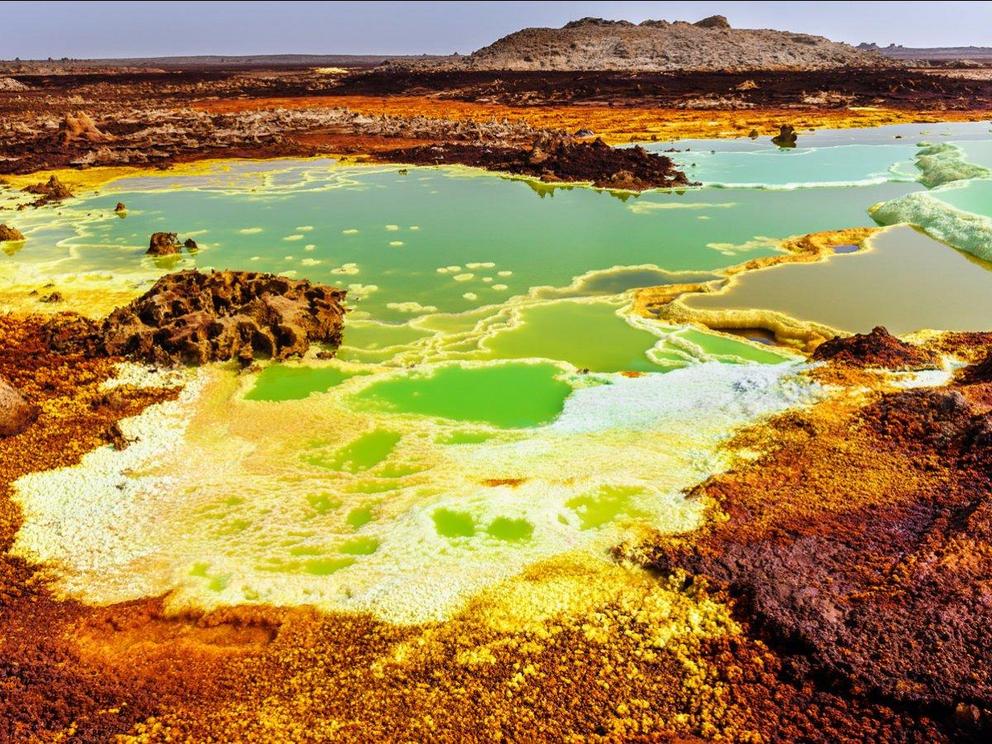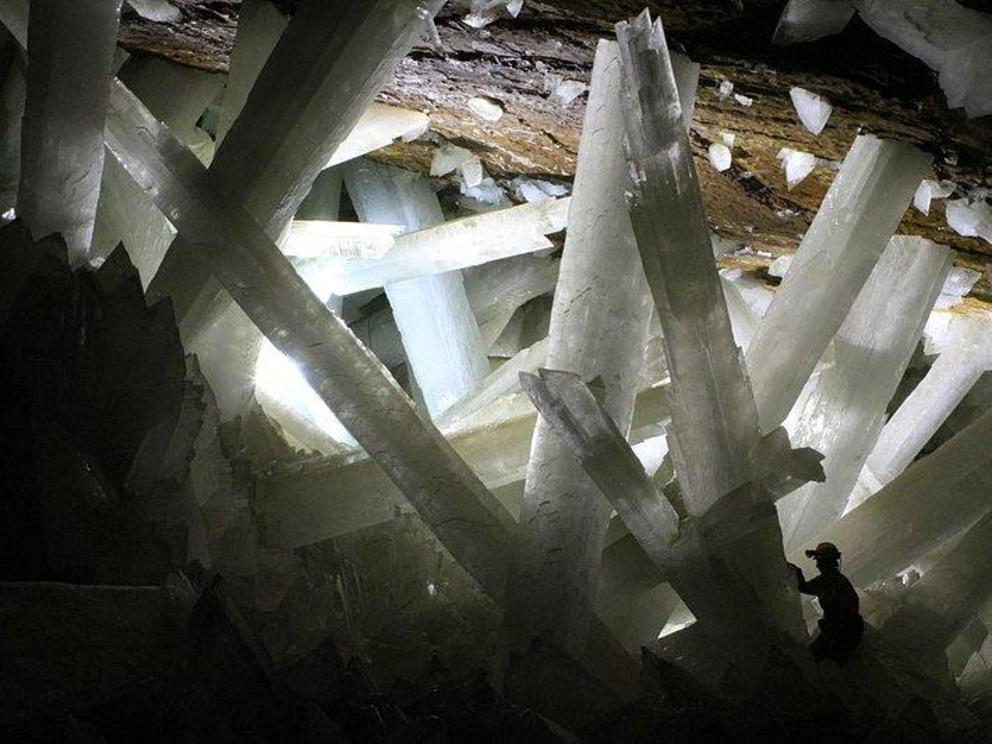Here are some of the strangest things on Earth you may not have heard of
The Earth is wonderfully weird. From tiny puddle-dwelling creatures that can survive in outer space to a paint so dark that your eyes can't actually even see it, Earth is filled with plenty of strange and incredible things - both natural and made by us.
Here are a handful of things on this planet that you probably had no idea existed.
1. Vantablack is the darkest known substance in the universe.

(Surrey Nanosystems)
Vantablack is a nanomaterial that is darker than any other substance on Earth. It was developed in the UK by Surrey NanoSystems in 2015 and is actually a collection of vertical carbon tubes that are "grown" on a substrate.
Vantablack absorbs 99.98 percent of the light that hits its surface. This means that the human eye technically sees nothing when it looks at Vantablack, making it the closest thing to staring into a black hole.
2. The blue angel sea slug looks like an alien.

Glaucus Atlanticus is a species of sea slug nicknamed the "blue angel." This otherworldly creature is as rare as it is beautiful and is only found on the coasts of South Africa and Australia.
The slug's mesmerising looks belie a dangerous nature.
The blue angel is carnivorous and feeds on other venomous sea creatures, such as the Portuguese man o' war. It collects the venom from its prey in specialised sacs, concentrates it, then uses the venom on future prey.
3. Aerogel looks like a slice of cloud.

(NASA/JPL-Caltech)
Aerogel is an ultralight material made from gel and gas. It's been nicknamed "frozen smoke" or "solid cloud" because of its ethereal appearance.
Scientists have created more than a dozen recipes for different types of aerogel, but they all share a similar process: mix chemicals together, let them settle into a wet gel, and then suck all of the liquid out. The result is a substance of extremely low density that is actually 99 percent air.
Because it's made primarily of air and air is such a terrible heat conductor, placing a layer of Aerogel between a flower and a flame will protect the flower from getting destroyed.
4. Rainbow eucalyptus trees have candy-coloured bark.

(Shutterstock)
The Eucalyptus Deglupta tree may look like it has fallen out of a Dr. Seuss book, but it actually grows in Indonesia, Papua New Guinea, and the Philippines. This unique tree has multicolored bark that features bright blue, orange, purple, green, and maroon streaks.
The unusual colours are a side effect of the tree's shedding, according to Missouri Botanical Garden – as strips of bark peel away, the tree's bright green inner bark is revealed. This inner layer slowly matures and turns a range of colours.
5. There's an underground cathedral in Colombia entirely made of salt.

(ollie harridge/Flickr/CC BY 2.0)
The Salt Cathedral of Zipaquirá is an underground Roman Catholic Church in Cundinamarca, Colombia, that was excavated from a salt mine in 1954. It is completely made of salt and is located 180 meters (590 feet) below the surface of the small town of Zipaquirá.
The cathedral includes a giant salt cross and can accommodate up to 10,000 people, though it has never been filled to capacity.
6. Goblin sharks are 'living fossils' that look straight out of a nightmare.

(Dianne Bray/Museum Victoria/Wikimedia/CC BY 3.0 AU)
Goblin sharks are a rare species of deep-sea shark that are sometimes referred to as "living fossils." They are the only known remaining member of the ancient Mitsukurinidae family of sharks.
Goblin sharks are notable for their distinctive elongated jaws, which are filled with nail-like teeth. They are able to detect the electrical currents emitted by other animals and rapidly extend their jaws in order to snatch up prey.
It's impossible to fully appreciate how horrifying this is without seeing footage of a goblin shark attacking its prey. This creature was actually the inspiration for the Neomorph in "Alien: Covenant," according to Digital Spy.
7. Bismuth is an element with a psychedelic surface.

(Shutterstock)
You may remember the chemical element bismuth from your high school chemistry class, but you probably had no idea that it has a colourful, iridescent appearance.
Bismuth has a unique "stair step" growth pattern in which the outer edges form more quickly than the inner areas, according to Live Science. This results in a crystalline structure that appears to be made of interlocking rainbow squares.
8. This volcano in Indonesia spews bright-blue lava - sort of.

(Shutterstock)
Indonesia's Kawah Ijen volcano is remarkable for its tendency to emit oozing waves of what appears to be blue and purple lava.
Technically, the lava itself isn't blue. According to Smithsonian Magazine, the fascinating coloration comes from high quantities of sulfuric gas that emerges along with the lava. When the gas catches fire, it burns with a bright hue that makes the lava appear to be electric blue.
9. The Voynich Manuscript is mysterious book written in an untranslatable language.

(Wikimedia Commons)
The Voynich Manuscript is a 240-page medieval tome written in an unknown language that has baffled scholars and code-breakers for years.
The manuscript is believed to have originated sometime between 1404 and 1438. It is filled with enigmatic illustrations and diagrams that seem to depict everything from unusual plants to women with swollen bellies bathing in green pools.
All attempts to translate the book's text or identify the plants depicted in it have failed.
In January 2018, a group of Canadian computer scientists announced that they may have had some limited success decoding parts of the manuscript using AI. The researchers, however, admitted that further refinement of the process and input from scholars is needed.
10. The most inaccessible place in the world is called Point Nemo.

(Cookson69/Wikipedia/CC BY-SA 3.0)
Point Nemo is the furthest point from land on Earth. Officially known as the oceanic point of inaccessibility, it's located in the center of the triangle made by Ducie Island, Motu Nui (part of the Easter Island chain) and Maher Island near Antarctica.
It is so far from land that the closest humans to Point Nemo are usually astronauts – the International Space Station orbits the Earth from a distance of about 258 miles (415 kilometres), while the closest inhabited spot to Point Nemo is more than 1,670 miles (1,225 kilometres) away.
11. The Danakil Depression looks like the surface of an alien planet.

(Shutterstock/Aleksandra H. Kossowska)
Ethiopia's Danakil Depression is home to one of the most bizarre-looking landscapes on Earth.
Located in the Afar Triangle, this surreal spot is dotted with crackling lava pools, neon-coloured hot springs, and sparkling salt flats. Poisonous gases swirl around hydrothermal fields, and many of the area's pools are filled with acid.
12. There are underwater lakes and rivers within the ocean.

(Wikimedia Commons)
Also known as brine pools, underwater lakes are bodies of water that have a much higher salinity (i.e. saltiness) than the surrounding ocean. The briny water is denser than the rest of the seawater, which causes underwater lakes to form that appear separate from the surrounding sea.
These lakes have distinct waves of their own that lap against the "shoreline," and submarines can even float on these brine pools when they descend to the ocean floor.
Unfortunately, these lakes also contain high amounts of toxic methane and hydrogen sulfide, so swimming in them would be toxic for humans.
13. The biggest living thing on Earth is a massive fungus.

(Shutterstock)
Whales, redwood trees, and elephants are all very big – but they're not the largest living organism on the planet by acreage. That title, when looking at sheer size – the Pando tree colony holds the title of the largest living organism by mass – goes to the Armillaria Ostoyae mushroom.
Nicknamed the Humongous Fungus, this mushroom has spread across 2,385 acres of Malheur National Forest in Oregon. The scientists who discovered the fungus in 2017 used DNA testing to determine that all parts of the growth are in fact different segments of the same organism.
The giant mushroom has probably been growing for between 2,400 to 8,650 years, and its caps are said to be quite delicious.
14. Tardigrades are microorganisms that can survive in outer space.

(Shutterstock)
Tardigrades, also called water bears or moss piglets, are fascinating microorganisms that can survive just about anywhere.
They prefer to hang out in moist places like mud or moss, but according to Smithsonian magazine, the creatures can survive in environments at least as cold as -328 degrees Fahrenheit (-200 degrees Celsius) or as hot as 300 degrees Fahrenheit (149 degrees Celsius).
Scientists have also found that water bears can survive radiation, boiling liquids, pressures more than six times that of the deepest part of the ocean, and even the vacuum of space.
15. There's a cave in Mexico filled with towering white crystals.

(Wikimedia Commons)
Fittingly known as the Cueva de los Cristales or The Cave of Crystals, this enchanting cavern is crisscrossed with gleaming gypsum crystals that dwarf human explorers.
This mysterious spot was only discovered in 2000 when miners drained the water from a zinc mine beneath Naica, in the Mexican state of Chihuahua.
The sparkling structures are so pure that scientists are unable to date them using conventional techniques. But researchers have discovered what is believed to be a 50,000-year-old bacteria sample within one of the crystals.
In 2017, the mining company that owns the property where the cave is located allowed the cave to reflood.
For full references please use source link below.
